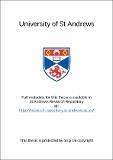Novel optical micromanipulation techniques and applications of violet diode lasers
Abstract
In this thesis, optical micro-manipulation experiments are described using laser sources spanning the wavelength region 1064 nm to 410 nm. Optical guiding is studied at near infrared wavelengths (780 nm) for comparison of a Gaussian and Bessel beam. The Bessel beam offers good transverse confinement. Extended guiding distances with the Bessel beam are shown with an enhancement factor of 3 over the Gaussian beam. Optical binding is observed in counter-propagating Gaussian beams using infrared light (at 780 nm and 1064 nm). In this geometry, the light-matter interaction induces particles to arrange themselves within a one-dimensional, regularly spaced particle array. A theoretical model is discussed to provide insight into the experimental data. Optical tweezing is performed using newly available short (violet) wavelength laser sources. The optical tweezers' trapping efficiencies were compared with a more traditional infrared source for tweezing. In addition, the violet lasers were used for biological spectroscopy, performing excitation of dyed chromosomes, and green fluorescent protein within cells. Finally, a violet microlensed diode laser at 413 nm is used with a microlensed diode at 662 nm for generating ultraviolet light in a non-linear sum frequency arrangement. This allows spectroscopy of atomic mercury at 254 nm to be performed.
Type
Thesis, PhD Doctor of Philosopy
Collections
Items in the St Andrews Research Repository are protected by copyright, with all rights reserved, unless otherwise indicated.

